ESP Hyundai Tucson 2020 Owner's Manual - RHD (UK, Australia)
[x] Cancel search | Manufacturer: HYUNDAI, Model Year: 2020, Model line: Tucson, Model: Hyundai Tucson 2020Pages: 637, PDF Size: 64.45 MB
Page 23 of 637

2-2
You will find many safety precautions
and recommendations throughout
this section, and throughout this
manual. The safety precautions in
this section are among the most
important.
Always wear your seat belt
A seat belt is your best protection in
all types of accidents. Air bags are
designed to supplement seat belts,
not replace them. So even though
your vehicle is equipped with air
bags, ALWAYS make sure you and
your passengers wear the seat belts,
and wear them properly.
Restrain all children
All children under age 13 should ride
in your vehicle properly restrained in
a rear seat, not the front seat. Infants
and small children should be
restrained in an appropriate Child
Restraint System. Larger children
should use a booster seat with the
lap/shoulder belt until they can use
the seat belt properly without a
booster seat.
Air bag hazards
Whilst air bags can save lives, they
can also cause serious or fatal
injuries to occupants who sit too
close to them, or who are not proper-
ly restrained. Infants, young children,
and short adults are at the greatest
risk of being injured by an inflating air
bag. Follow all instructions and warn-
ings in this manual.
Driver distraction
Driver distraction presents a serious
and potentially deadly danger, espe-
cially for inexperienced drivers.
Safety should be the first concern
when behind the wheel and drivers
need to be aware of the wide array of
potential distractions, such as
drowsiness, reaching for objects,
eating, personal grooming, other
passengers, and using mobile
phones.
Drivers can become distracted when
they take their eyes and attention off
the road or their hands off the wheel
to focus on activities other than driv-
ing. To reduce your risk of distraction
and an accident:
• ALWAYS set up your mobile
devices (i.e., MP3 players, phones,
navigation units, etc.) when your
vehicle is parked or safely stopped.
ONLY use your mobile device
when laws and conditions permit
safe use. NEVER text or email
whilst driving. Most countries have
laws prohibiting drivers from tex-
ting. Some countries and cities
also prohibit drivers from using
handheld phones.
I IM
MP
PO
OR
RT
TA
AN
NT
T
S
SA
AF
FE
ET
TY
Y
P
PR
RE
EC
CA
AU
UT
TI
IO
ON
NS
S
Safety system of your vehicle
Page 24 of 637

2-3
Safety system of your vehicle
NEVER let the use of a mobile
device distract you from driving.
You have a responsibility to your
passengers and others on the road
to always drive safely, with your
hands on the wheel as well as your
eyes and attention on the road.
Control your speed
Excessive speed is a major factor in
crash injuries and deaths. Generally,
the higher the speed, the greater the
risk, but serious injuries can also
occur at lower speeds. Never drive
faster than is safe for current condi-
tions, regardless of the maximum
speed posted.
Keep your vehicle in a safe
condition
Having a tyre blowout or a mechani-
cal failure can be extremely haz-
ardous. To reduce the possibility of
such problems, check your tyre pres-
sures and condition frequently, and
perform all regularly scheduled
maintenance.
2
Page 27 of 637

2-6
Safety system of your vehicle
Front seats
The front seat can be adjusted by
using the control switches located on
the outside of the seat cushion.
Before driving, adjust the seat to the
proper position so that you can easi-
ly control the steering wheel, foot
pedals and controls on the instru-
ment panel. Take the following precautions
when adjusting your seat belt:
NEVER use one seat belt for
more than one occupant.
Always position the seatback
upright with the lap portion of
the seat belt snug and low
across the hips.
NEVER allow children or
small infants to ride in a pas-
senger’s lap.
Do not route the seat belt
across your neck, across
sharp edges, or reroute the
shoulder strap away from
your body.
Do not allow the seat belt to
become caught or jammed.WARNING
Take the following precautions
when adjusting your seat:
NEVER attempt to adjust the
seat whilst the vehicle is mov-
ing. The seat could respond
with unexpected movement
and may cause loss of vehicle
control resulting in an acci-
dent.
Do not place anything under
the front seats. Loose objects
in the driver’s foot area could
interfere with the operation of
the foot pedals, causing an
accident.
WARNING
Do not allow anything to inter-
fere with the normal position
and proper locking of the
seatback.
Do not place a cigarette
lighter on the floor or seat.
When you operate the seat,
gas may exit out of the lighter
causing a fire.
Use extreme caution when
picking up small objects
trapped under the seats or
between the seat and the cen-
tre console. Your hands might
be cut or injured by the sharp
edges of the seat mechanism.
If there are occupants in the
rear seats, be careful whilst
adjusting the front seat posi-
tion.
Page 36 of 637

2-15
Safety system of your vehicle
2
Headrest
The vehicle’s front and rear seats
have adjustable headrests. The
headrests provide comfort for pas-
sengers, but more importantly they
are designed to help protect passen-
gers from whiplash and other neck
and spinal injuries during an acci-
dent, especially in a rear impact col-
lision.To prevent damage, NEVER hit or
pull on the headrests.
NOTICE
When there are no occupants in
the rear seats, adjust the height
of the headrests to the lowest
position. The rear seat headrest
can reduce visibility at the rear
of the vehicle.
CAUTION
To reduce the risk of serious
injury or death in an accident,
take the following precautions
when adjusting your headrests:
Always properly adjust the
headrests for all passengers
BEFORE starting the vehicle.
NEVER let anyone ride in a
seat with the headrest
removed.
Adjust the headrest so the
middle of the headrests is at
the same height as the height
of the top of the eyes.
NEVER adjust the headrest
position of the driver’s seat
when the vehicle is in motion.
Adjust the headrest as close
to the passenger’s head as
possible. Do not use a seat
cushion that holds the body
away from the seatback.
Make sure the headrest locks
into position after adjusting it.
WARNING
OLF034072N
Page 40 of 637

2-19
Safety system of your vehicle
2
Adjusting the height up and down
To raise the headrest:
1. Pull it up to the desired position
(1).
To lower the headrest:
1. Push and hold the release button
(2) on the headrest support.
2. Lower the headrest to the desired
position (3).
Seat warmers and air ventila-
tion seats
Front seat warmers
(if equipped)
Seat warmers are provided to warm
the seats during cold weather.
To prevent damage to the seat
warmers and seats:
Never use a solvent such as
paint thinner, benzene, alcohol
or petrol to clean the seats.
Do not place heavy or sharp
objects on seats equipped with
seat warmers.
Do not change the seat cover. It
may damage the seat warmer.
NOTICE
The seat warmers can cause a
SERIOUS BURN, even at low
temperatures and especially if
used for long periods of time.
Passengers must be able to feel
if the seat is becoming too
warm so they can turn it off, if
needed.
People who cannot detect tem-
perature change or pain to the
skin should use extreme cau-
tion, especially the following
passengers:
Infants, children, elderly or
disabled persons, or hospital
outpatients.
People with sensitive skin or
who burn easily.
Fatigued individuals.
Intoxicated individuals.
People taking medication that
can cause drowsiness or
sleepiness.
WARNING
NEVER place anything on the
seat that insulates against heat
when the seat warmer is in oper-
ation, such as a blanket or seat
cushion. This may cause the
seat warmer to overheat, caus-
ing a burn or damage to the seat.
WARNING
OTL035018
Page 46 of 637
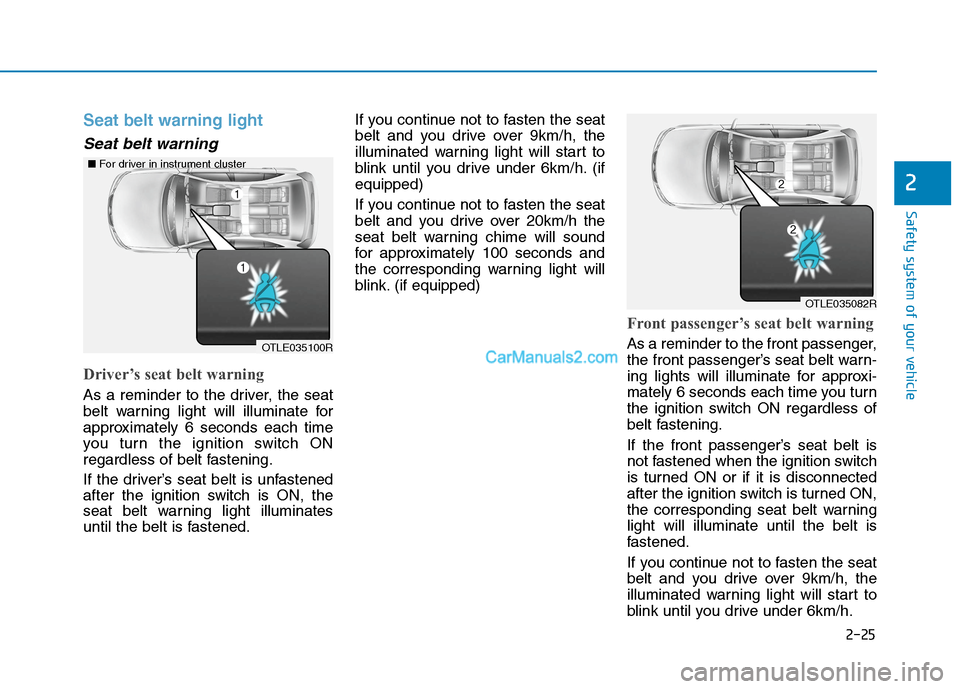
2-25
Safety system of your vehicle
Seat belt warning light
Seat belt warning
Driver’s seat belt warning
As a reminder to the driver, the seat
belt warning light will illuminate for
approximately 6 seconds each time
you turn the ignition switch ON
regardless of belt fastening.
If the driver’s seat belt is unfastened
after the ignition switch is ON, the
seat belt warning light illuminates
until the belt is fastened.If you continue not to fasten the seat
belt and you drive over 9km/h, the
illuminated warning light will start to
blink until you drive under 6km/h. (if
equipped)
If you continue not to fasten the seat
belt and you drive over 20km/h the
seat belt warning chime will sound
for approximately 100 seconds and
the corresponding warning light will
blink. (if equipped)
Front passenger’s seat belt warning
As a reminder to the front passenger,
the front passenger’s seat belt warn-
ing lights will illuminate for approxi-
mately 6 seconds each time you turn
the ignition switch ON regardless of
belt fastening.
If the front passenger’s seat belt is
not fastened when the ignition switch
is turned ON or if it is disconnected
after the ignition switch is turned ON,
the corresponding seat belt warning
light will illuminate until the belt is
fastened.
If you continue not to fasten the seat
belt and you drive over 9km/h, the
illuminated warning light will start to
blink until you drive under 6km/h.
2
OTLE035100R ■For driver in instrument cluster
OTLE035082R
Page 47 of 637
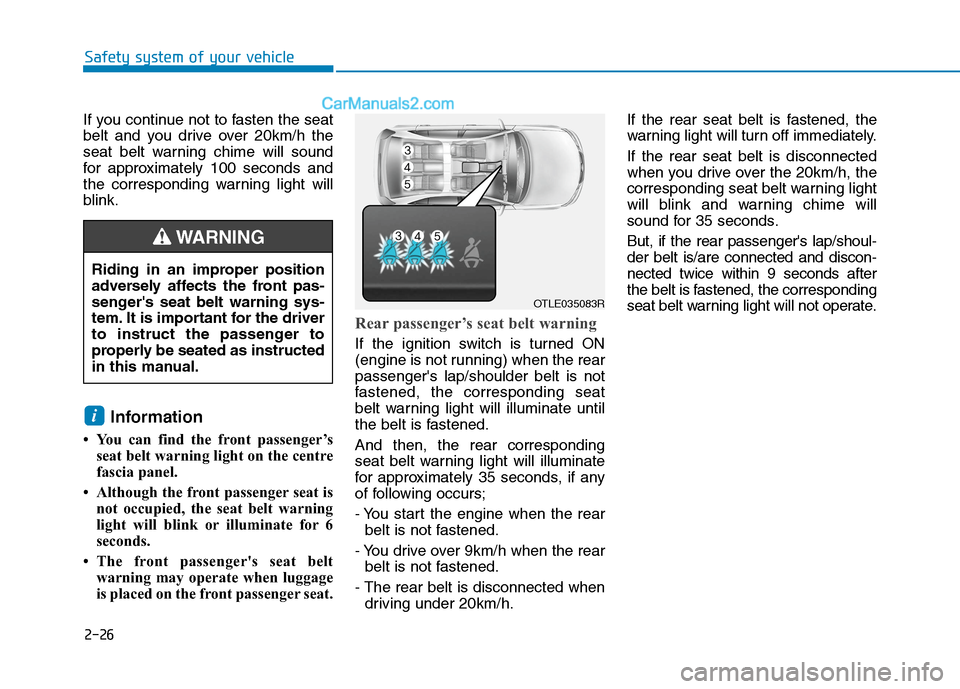
2-26
Safety system of your vehicle
If you continue not to fasten the seat
belt and you drive over 20km/h the
seat belt warning chime will sound
for approximately 100 seconds and
the corresponding warning light will
blink.
Information
• You can find the front passenger’s
seat belt warning light on the centre
fascia panel.
• Although the front passenger seat is
not occupied, the seat belt warning
light will blink or illuminate for 6
seconds.
• The front passenger's seat belt
warning may operate when luggage
is placed on the front passenger seat.
Rear passenger’s seat belt warning
If the ignition switch is turned ON
(engine is not running) when the rear
passenger's lap/shoulder belt is not
fastened, the corresponding seat
belt warning light will illuminate until
the belt is fastened.
And then, the rear corresponding
seat belt warning light will illuminate
for approximately 35 seconds, if any
of following occurs;
- You start the engine when the rear
belt is not fastened.
- You drive over 9km/h when the rear
belt is not fastened.
- The rear belt is disconnected when
driving under 20km/h.If the rear seat belt is fastened, the
warning light will turn off immediately.
If the rear seat belt is disconnected
when you drive over the 20km/h, the
corresponding seat belt warning light
will blink and warning chime will
sound for 35 seconds.
But, if the rear passenger's lap/shoul-
der belt is/are connected and discon-
nected twice within 9 seconds after
the belt is fastened, the corresponding
seat belt warning light will not operate.
i
Riding in an improper position
adversely affects the front pas-
senger's seat belt warning sys-
tem. It is important for the driver
to instruct the passenger to
properly be seated as instructed
in this manual.
WARNING
OTLE035083R
Page 61 of 637
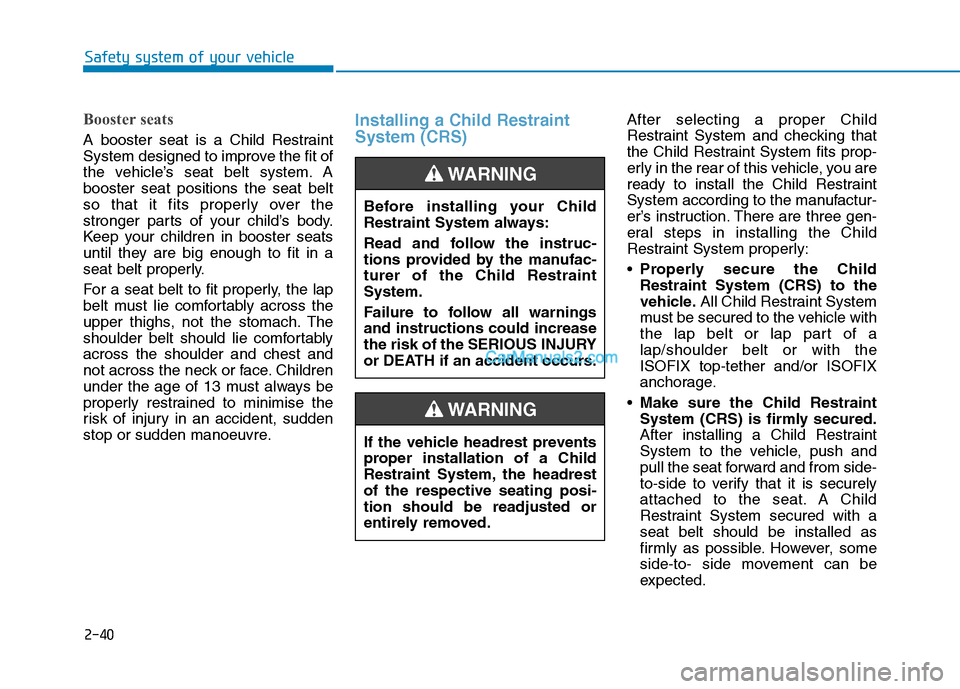
2-40
Safety system of your vehicle
Booster seats
A booster seat is a Child Restraint
System designed to improve the fit of
the vehicle’s seat belt system. A
booster seat positions the seat belt
so that it fits properly over the
stronger parts of your child’s body.
Keep your children in booster seats
until they are big enough to fit in a
seat belt properly.
For a seat belt to fit properly, the lap
belt must lie comfortably across the
upper thighs, not the stomach. The
shoulder belt should lie comfortably
across the shoulder and chest and
not across the neck or face. Children
under the age of 13 must always be
properly restrained to minimise the
risk of injury in an accident, sudden
stop or sudden manoeuvre.
Installing a Child Restraint
System (CRS)After selecting a proper Child
Restraint System and checking that
the Child Restraint System fits prop-
erly in the rear of this vehicle, you are
ready to install the Child Restraint
System according to the manufactur-
er’s instruction. There are three gen-
eral steps in installing the Child
Restraint System properly:
Properly secure the Child
Restraint System (CRS) to the
vehicle.All Child Restraint System
must be secured to the vehicle with
the lap belt or lap part of a
lap/shoulder belt or with the
ISOFIX top-tether and/or ISOFIX
anchorage.
Make sure the Child Restraint
System (CRS) is firmly secured.
After installing a Child Restraint
System to the vehicle, push and
pull the seat forward and from side-
to-side to verify that it is securely
attached to the seat. A Child
Restraint System secured with a
seat belt should be installed as
firmly as possible. However, some
side-to- side movement can be
expected. Before installing your Child
Restraint System always:
Read and follow the instruc-
tions provided by the manufac-
turer of the Child Restraint
System.
Failure to follow all warnings
and instructions could increase
the risk of the SERIOUS INJURY
or DEATH if an accident occurs.
WARNING
If the vehicle headrest prevents
proper installation of a Child
Restraint System, the headrest
of the respective seating posi-
tion should be readjusted or
entirely removed.
WARNING
Page 63 of 637
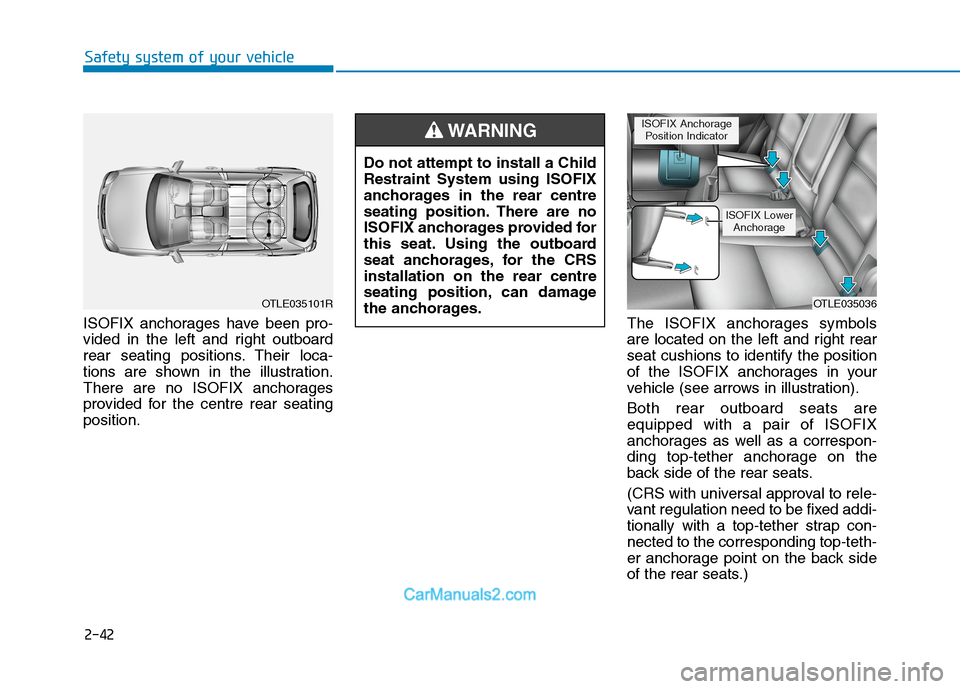
2-42
Safety system of your vehicle
ISOFIX anchorages have been pro-
vided in the left and right outboard
rear seating positions. Their loca-
tions are shown in the illustration.
There are no ISOFIX anchorages
provided for the centre rear seating
position.The ISOFIX anchorages symbols
are located on the left and right rear
seat cushions to identify the position
of the ISOFIX anchorages in your
vehicle (see arrows in illustration).
Both rear outboard seats are
equipped with a pair of ISOFIX
anchorages as well as a correspon-
ding top-tether anchorage on the
back side of the rear seats.
(CRS with universal approval to rele-
vant regulation need to be fixed addi-
tionally with a top-tether strap con-
nected to the corresponding top-teth-
er anchorage point on the back side
of the rear seats.) Do not attempt to install a Child
Restraint System using ISOFIX
anchorages in the rear centre
seating position. There are no
ISOFIX anchorages provided for
this seat. Using the outboard
seat anchorages, for the CRS
installation on the rear centre
seating position, can damage
the anchorages.
WARNING
OTLE035036
ISOFIX Anchorage
Position Indicator
ISOFIX Lower
Anchorage
OTLE035101R
Page 74 of 637
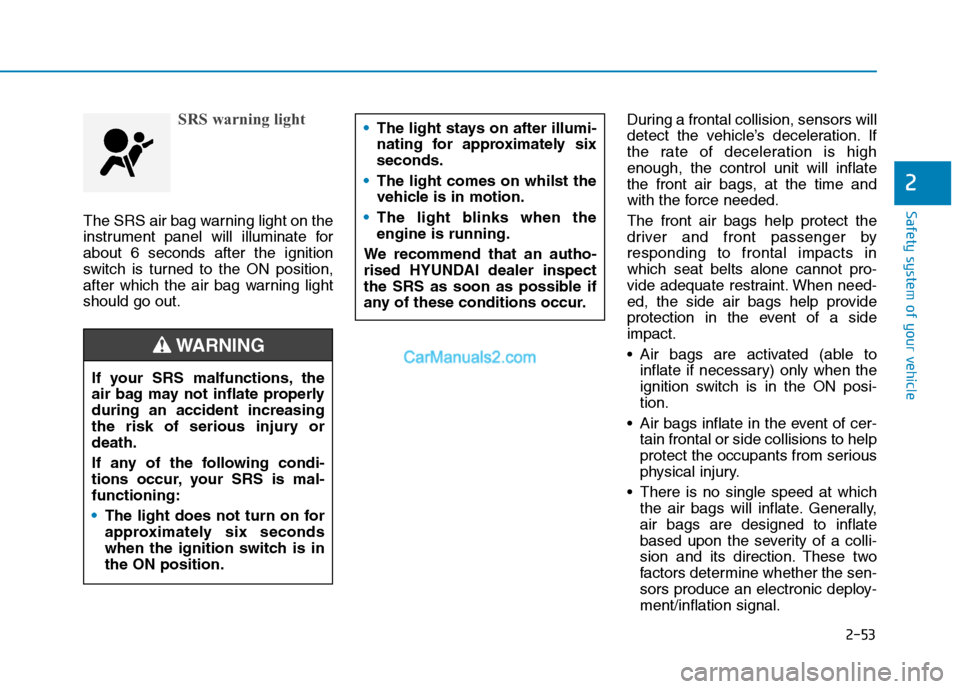
2-53
Safety system of your vehicle
2
SRS warning light
The SRS air bag warning light on the
instrument panel will illuminate for
about 6 seconds after the ignition
switch is turned to the ON position,
after which the air bag warning light
should go out.During a frontal collision, sensors will
detect the vehicle’s deceleration. If
the rate of deceleration is high
enough, the control unit will inflate
the front air bags, at the time and
with the force needed.
The front air bags help protect the
driver and front passenger by
responding to frontal impacts in
which seat belts alone cannot pro-
vide adequate restraint. When need-
ed, the side air bags help provide
protection in the event of a side
impact.
Air bags are activated (able to
inflate if necessary) only when the
ignition switch is in the ON posi-
tion.
Air bags inflate in the event of cer-
tain frontal or side collisions to help
protect the occupants from serious
physical injury.
There is no single speed at which
the air bags will inflate. Generally,
air bags are designed to inflate
based upon the severity of a colli-
sion and its direction. These two
factors determine whether the sen-
sors produce an electronic deploy-
ment/inflation signal. The light stays on after illumi-
nating for approximately six
seconds.
The light comes on whilst the
vehicle is in motion.
The light blinks when the
engine is running.
We recommend that an autho-
rised HYUNDAI dealer inspect
the SRS as soon as possible if
any of these conditions occur.
If your SRS malfunctions, the
air bag may not inflate properly
during an accident increasing
the risk of serious injury or
death.
If any of the following condi-
tions occur, your SRS is mal-
functioning:
The light does not turn on for
approximately six seconds
when the ignition switch is in
the ON position.
WARNING